Enter the world of toxic backlinks – a term that strikes fear into the hearts of website owners and SEO practitioners alike.
Toxic backlinks are like hidden landmines in your site’s link profile, capable of causing severe damage to your online presence.
They can lead to penalties from search engines, plummeting rankings, and even the dreaded “sandbox” effect, where your website is virtually invisible to users.
If you limit your definition of “toxic backlinks” to SEO tools, you will likely disavow a legit backlink.
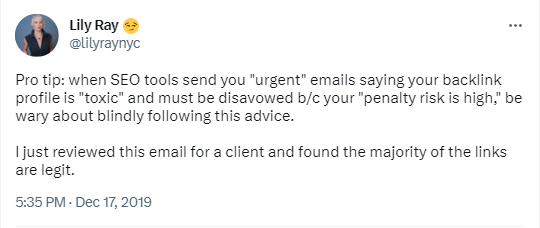
And that will be painful, eh?
BTW, we’re not saying you should disregard toxic backlink reports. Do this instead:
Review your links INDIVIDUALLY and MANUALLY before tagging them as “toxic.”
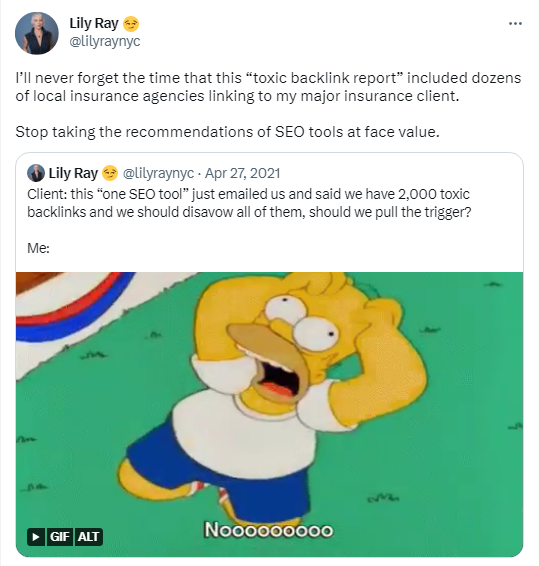
In other words, you must FULLY understand what makes a link toxic. That is the only way to avoid losing your hard-earned, high-quality backlinks.
So, what makes a link toxic? What are toxic backlinks?
Read along as we teach you how to identify and fix toxic backlinks.
What Are Good Backlinks?
Good or “safe” backlinks have a positive impact on your search engine ranking.
Search engines do not disclose the specific criteria for determining quality links, but good backlinks typically exhibit the following characteristics:
- Relevance: High-quality backlinks are closely related to the content on the linking and linked-to websites. They contribute contextually to the subject matter, enhancing the user experience and credibility.
- Authority: Such backlinks often originate from authoritative and reputable sources within your industry or niche. Websites with a strong online presence are more likely to provide valuable, trust-worthy links.
- Organic Growth: High-quality backlinks are naturally acquired, indicating that they result from genuine interest or appreciation of your content. They are not a product of link schemes or manipulative tactics.
- Diverse Sources: A diverse list of links from various websites and domains is a positive sign. It signifies that your content is well-regarded across different corners of the internet.
- Editorial Endorsement: These backlinks are typically earned through editorial endorsement. This means that website owners or content creators link to your piece of content because they genuinely find it valuable and relevant.
- Sustainability: High-quality backlinks stand the test of time. They are not fleeting, unlike harmful links that may lead to penalties from search engines.
- Natural Anchor Text: The anchor text used in these backlinks is often diverse and reflects the content’s subject matter naturally. Over-optimized anchor text can be a red flag for search engines.
- Backlink Audits: Conducting periodic backlink audits is essential. This practice helps you identify and disavow harmful links that could negatively impact your search ranking.
- Utilizing Backlink Checkers: Employing backlink checker tools can assist you in tracking the quality and quantity of your backlinks. This information is invaluable for optimizing your SEO strategy.
- Avoiding Bad Links: Just as it is crucial to acquire good backlinks, it’s equally important to steer clear of bad links that originate from low-quality or spammy websites. Such links can harm your website’s reputation and ranking.
It ensures that your website gains credibility, visibility, and higher search engine rankings, while steering clear of the pitfalls associated with harmful links and link schemes.
Regularly evaluating your backlink profile through backlink audits and utilizing backlink checkers can help you maintain a robust and effective SEO strategy.
What Are Toxic Backlinks? Everything You Must Know
According to Search Engine Land, a toxic link is any backlink that can harm your site’s ranking ability.
WowVisible paints a vivid picture — likening “toxic backlinks” to an artificially ripened fruit. And because of the “artificial-ness,” such links can endanger the body (your website).
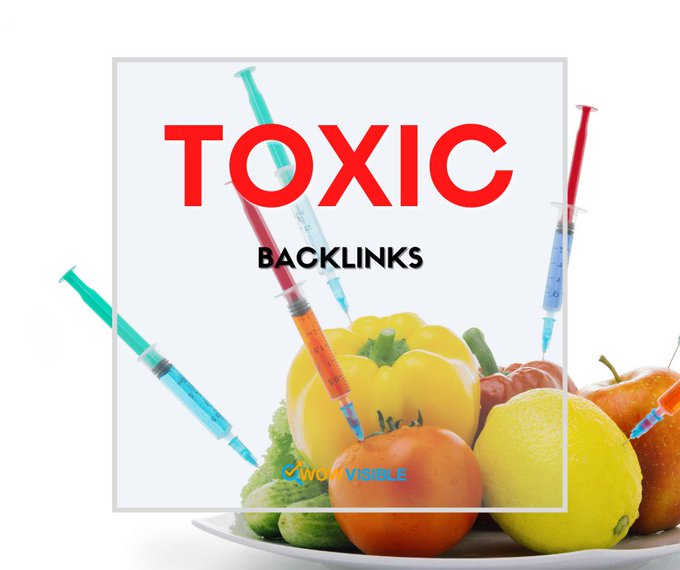
With such definitions, any spammy link could pass as toxic. And talking of spammy links, they are clearly defined by Google.
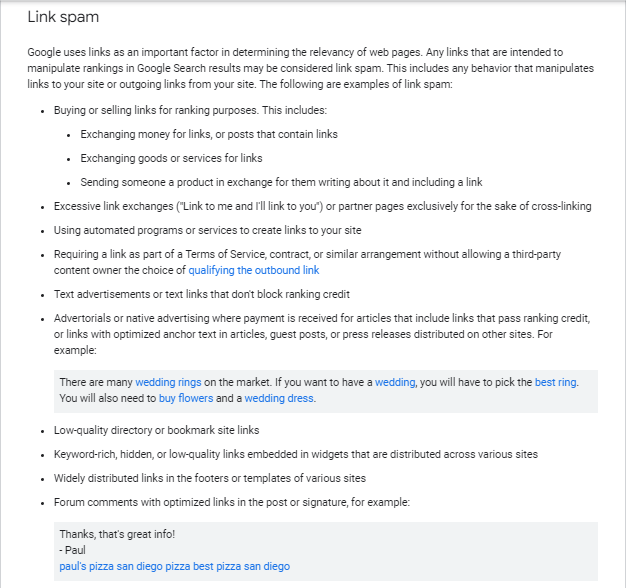
Funnily enough, you won’t find “toxic” on the long list of Google’s examples. Maybe Google doesn’t think of any backlink as toxic.
What Is Google Saying?
A while back, a tweet raised a query about backlinks with high toxic scores.
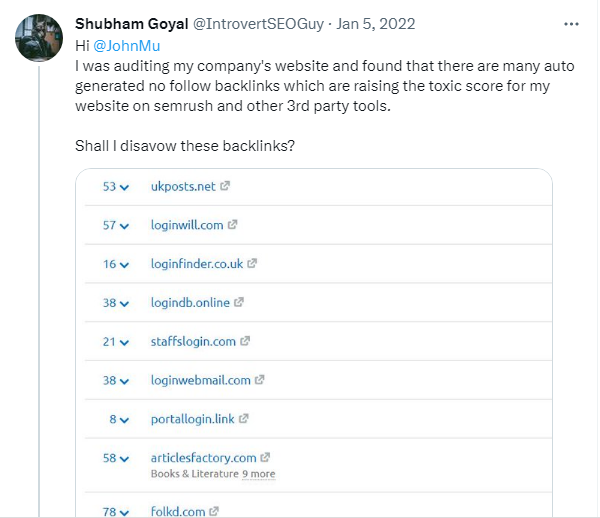
John Mu replied that the tweet should ignore the scores. And that “some tools make assumptions about Google.”
In the same thread, another tweet specifically asked how to identify and remove toxic backlinks. Here is John Mu’s reply:
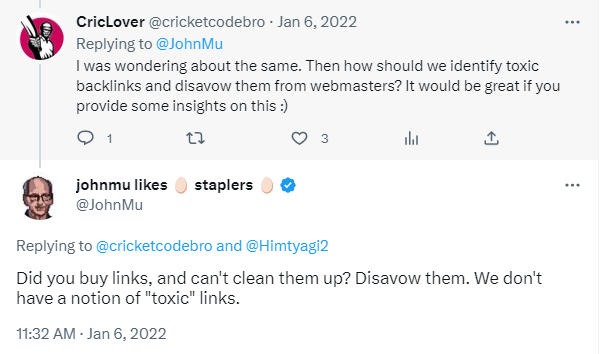
If Google doesn’t have anything like “toxic backlinks,” where does the phrase come from? More importantly, what does it mean?
Why Do SEOs Use The Phrase “Toxic Links”?
Like “link juice,” “toxic backlinks” is one of several popular phrases used by SEOs.
In fact, the term “toxic” is culled from SEO tools. The tools use programmed “toxic scores” to determine if a link’s unnaturalness can hurt your website.
In short, toxic links are backlinks deemed unnatural by SEO tools because of their spammy nature. And frankly, the reports from the said tools are USEFUL.
But as we advised earlier, verify the list before disavowing your backlinks.
How To Verify That A Link Is TRULY Toxic?
Identifying the nature of incoming links, whether they are editorial links or potentially spammy ones, requires keen observation. You can readily spot these distinctive features if you know where to look.
Evaluating the quality of a link is a vital skill in today’s digital landscape, which is rife with online scams, phishing endeavors, and malicious websites.
Being able to differentiate between genuinely valuable links and harmful ones can safeguard you against succumbing to cyber threats, such as a drop in ranking due to associations with spammy sites or identifying broken links through a backlink checker.
Follow the two-step process below.
Step 1: Crosscheck Your Backlink Report With Google Search Console
Let’s say you got a toxic backlink report or notification from Semrush or even Majestic – or whatever SEO tool was employed.
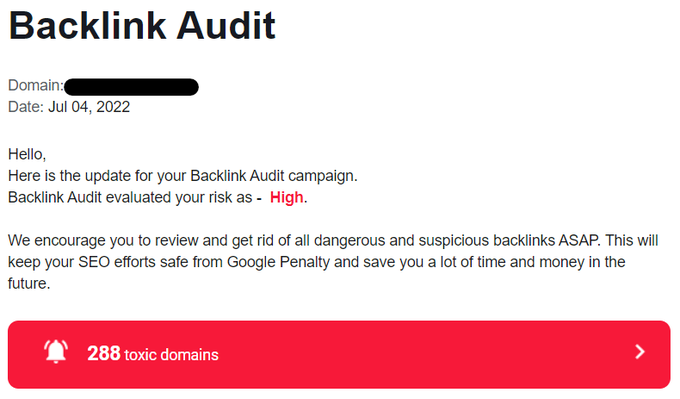
Don’t act instantly!
Instead, go over to your Google Search Console. Scroll to:
- Search Traffic > Manual Actions, or
- Security And Manual Actions > Manual Actions
Did you find any instructions about any unnatural links?
If yes, are the links the same as your toxic backlink mail?
Use the questions to trim down the long list.
Step 2: Use A Checklist
At Serpreach, we use a 5-way checklist to verify our clients’ backlink reports. You can also adopt the method — or create your own.
Either way, here’s the checklist:
- The content—what is the quality of the article? Is it spun content? More importantly, does it match users’ intents?
- The anchor text—is the anchor unnatural and unrelated? Was it too long and obviously designed for link building purposes?
- The website—is it another templated design? Are there bylines for the content written—even if it is as generic as “content team”? Is there an “about page”?
- Organic traffic—are search engines sending any traffic to the backlink source?
- The number of links sent—is the content or page sending backlinks to other sites? How many?
Overall: if a suspected toxic backlink features in Google Search Console’s Manual Action and fails the checklist, it is indeed “toxic.”
So, should you be worried if you have such backlinks on your site?
Should You Be Worried About Toxic Backlinks?
In a poll of 182 votes organized by a tweep, over half of the respondents ignore spammy links (toxic links included).
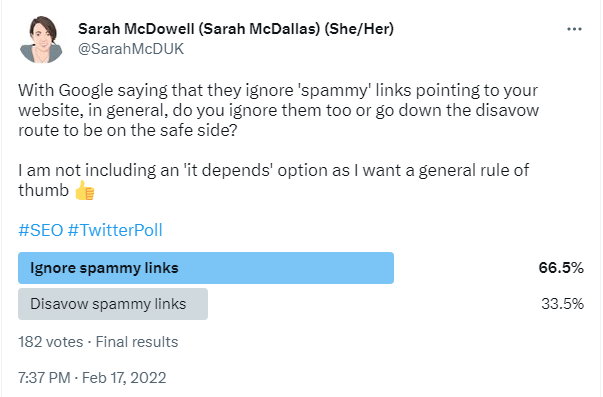
Maybe you should ignore the reports and emails too?
It depends on the nature of the backlink!
You should be worried if the toxic link is as “toxic” as black hats. Such backlinks shouldn’t be ignored.
Otherwise, you could be temporarily banned from search results.
Read more about black hat backlinks!
[Hyperlink to our article on the topic]
Our take: disavow all the links on your manual action list. Indeed, ignoring them might have no impact.
Disavowing the links, on the other hand, might increase your ranking.
That said, let’s discuss how to disavow toxic backlinks.
How To Disavow Toxic Backlinks?
To better teach you how to disavow toxic links, we will split this section into 3 parts:
- Understanding why SEOs get toxic backlinks
- Knowing the common types of toxic backlinks
- Removing toxic backlinks from your site
Why Do SEOs Get Toxic Backlinks?
If you’re actively looking to dissociate from a detrimental backlink, it’s likely that you’ve outsourced your link building campaign.
Otherwise, you wouldn’t want to invest your time attracting undesirable “spam links.”
So, why did your hiring decision take this detrimental turn?
Regrettably, many self-proclaimed “experts” lack the necessary knowledge. After initially building your link profile organically, they might employ dubious promotional techniques, tarnishing your positive SEO efforts.
In such instances, your backlinks can morph into toxic elements, harming your search engine visibility.
In other scenarios, SEO professionals prioritize speedy results in their pursuit of accumulating more victories and revenue.
What steps should you take?
First and foremost, update your understanding of link building and how to identify “spam services” before enlisting any assistance.
Be vigilant in assessing external websites’ links to your site, preferably on a regular basis, and consider utilizing a links tool to monitor link toxicity.
Also, safeguard your email address from being associated with harmful spam links.
Our blog is the place to start.
3 Common Types Of Toxic Backlinks
The often-used spammy link techniques include:
- Pillow links
- PBNs
- Link farms
Pillow links are backlinks obtained from low-quality sites such as directories and forums. By design, they (pillow links) are not toxic. But that could change when you use them unnaturally to send link juice to your site.
PBNs, on the other hand, are shady from the get-go. How so?
In PBN link building, you send backlinks from a network of hidden sites to manipulate your rankings in search results.
Note: PBN links are not only toxic; they are outrightly manipulative.
Link farms are PBNs that have been discovered by Google. They can no longer pass any juice to your site.
Beyond being toxic, getting backlinks from link farms is time-wasting. Avoid such techniques.
Removing Toxic Backlinks From Your Site
In general, the process of eliminating low-quality inbound links from your website can be accomplished by either reaching out to the webmaster responsible for the source or by utilizing Google’s resources.
Nevertheless, we discourage the webmaster outreach method due to its time-consuming nature. It can be quite challenging to locate contact information for a website, particularly if it lacks an “about page.”
Let’s assume you manage to find the contact information. It’s important to note that site owners may not always respond to your inquiries.
In contrast, submitting a list of unfavorable backlinks to Google can help rid your website of the harm these kinds of links have caused.
This approach operates at the domain level and assists in rectifying the effects of bad backlinks, ultimately improving the quality of your link-building efforts.
This way, you can effectively remove the stench of toxic backlinks from your site, promoting the cultivation of natural, high-quality links while addressing the concerns associated with blog posts and various types of links.
However, there are a few rules.
- The list must be submitted in a text file
- The domain, subdomain, and subpath for each link must be on a line
- You can only have 100k lines per “disavow file.”
After the list is ready, upload it to Google’s disavow link tool.
You Can Avoid Toxic Backlinks Through SAFE Link Building
At Serpreach, we encourage SEOs and business owners to build links naturally. It is more comfortable but takes time and resources.
However, you won’t constantly fear decreased rankings or a temporary ban from search results.
So, how can you build links naturally?
Do everything that is not toxic or spammy. This image by Attrock summarises the points.

But we’ll add this point:
Focus on building relationships with other businesses and individuals. Then, leverage the relationship to grow your digital marketing.
Further reading: White Hat Link Building
[Hyperlink to our article on the topic]
FAQs About Toxic Backlinks
Are Toxic Backlinks The Same As Spammy Links?
According to what Google thinks, spammy links violate the ranking system. They involve the use of unnatural link building techniques.
On the other hand, there is nothing like toxic backlinks in Google’s dictionary.
Practically, however, the two phrases are almost the same. One is Google-defined, and the other is attributed to backlinks by SEO tools.
Either way, they both suggest that something is wrong with your backlinks.
How Do I Know If My Backlink Is Toxic?
By definition, SEO tools reveal the toxicity of backlinks. But as we have explained, the suggestions are not always correct.
In that case, here is how to know if your backlink can TRULY harm your site:
- Crosscheck the backlink report with your Manual Actions list on Google Search Console
- Manually vet the links with the checklist described in this article
Do Toxic Backlinks Affect SEO?
According to Google, it doesn’t matter if your site has toxic backlinks. The bots won’t interpret them or add/reduce link juice to your site.
In other words, spammy/toxic backlinks can’t influence SEO.
However, we recommend that you disavow your toxic and spammy links — not just for Google but because of the benefits of building links naturally.
Should I Remove Toxic Backlinks?
Short answer: yes!
BTW, it’s okay if you decide to ignore spammy backlinks. Even if that is the case, ensure you disavow black hat links.
Can A Site Be Banned Permanently For Having Toxic Backlinks?
No!
Google hardly bans a site permanently from search results. They only do so temporarily — for the illegal, criminal black hat strategies.
